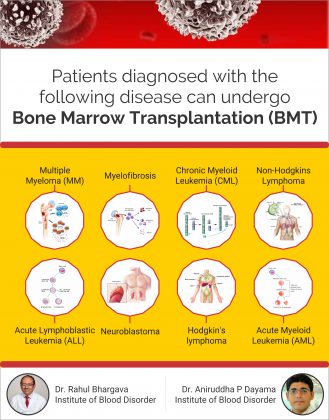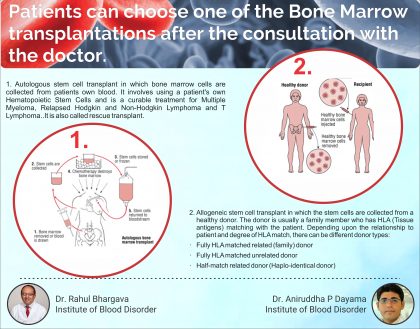- Home
- Editorial
- News
- Practice Guidelines
- Anesthesiology Guidelines
- Cancer Guidelines
- Cardiac Sciences Guidelines
- Critical Care Guidelines
- Dentistry Guidelines
- Dermatology Guidelines
- Diabetes and Endo Guidelines
- Diagnostics Guidelines
- ENT Guidelines
- Featured Practice Guidelines
- Gastroenterology Guidelines
- Geriatrics Guidelines
- Medicine Guidelines
- Nephrology Guidelines
- Neurosciences Guidelines
- Obs and Gynae Guidelines
- Ophthalmology Guidelines
- Orthopaedics Guidelines
- Paediatrics Guidelines
- Psychiatry Guidelines
- Pulmonology Guidelines
- Radiology Guidelines
- Surgery Guidelines
- Urology Guidelines
Bone Marrow Transplant – A cure for Blood Cancer

It is a common myth that bone marrow donation causes pain and hurts.
With recent advances in the field of medical science, blood cancer is no more considered to be a fatal disease. Bone marrow transplantation has come up with a life- saving treatment to combat this life-threatening disease.
Bone Marrow is the soft tissue inside the bones which contains Hematopoietic Stem Cells (HSC). Blood cancer can cause malfunctioning of Bone Marrow leading to abnormal production and functioning of blood components resulting in weakness, infections and bleeding ultimately leading to death. A bone marrow transplant is the most trusted and credible promising treatment procedure for blood cancer. It is similar to a blood transfusion in which the bone marrow cells are injected into the patient intravenously that replaces damaged marrow with a healthier one.
Patients diagnosed with the following disease can undergo Bone Marrow Transplantation (BMT)
- Multiple Myeloma (MM)
- Non-Hodgkins Lymphoma
- Hodgkin’s lymphoma
- Acute Myeloid Leukemia (AML)
- Acute Lymphoblastic Leukemia (ALL)
- Chronic Myeloid Leukemia (CML)
- Myelofibrosis
- Neuroblastoma
- Auto- Immune diseases - Systemic sclerosis, severe systemic juvenile rheumatoid arthritis, lupus, multiple sclerosis, Crohn disease, and others

Reasons to go for BMT
The patients with blood cancer should go for bone marrow transplant because of the following reasons
In case the patient’s bone marrow system has failed, the bone marrow cells injected from the donor can help in reviving the patient. This helps in rebuilding a healthy immune system.
It helps in replacing the defective bone marrow cells in the body that may be formed due to high dose chemotherapy or radiation.
It replaces any genetic errors that may have existed in the patient
Choosing the most beneficial BMT
Patients can choose one of the Bone Marrow transplantations after the consultation with the doctor.
Autologous stem cell transplant in which bone marrow cells are collected from patients own blood. It involves using a patient’s own Hematopoietic Stem Cells and is a curable treatment for Multiple Myeloma, Relapsed Hodgkin and Non-Hodgkin Lymphoma and T Lymphoma...It is also called rescue transplant.
Allogeneic stem cell transplant in which the stem cells are collected from a healthy donor. The donor is usually a family member who has HLA (Tissue antigens) matching with the patient. Depending upon the relationship to patient and degree of HLA match, there can be different donor types:
Fully HLA matched related (family) donor
Fully HLA matched unrelated donor
Half-match related donor (Haplo-identical donor)
Umbilical cord blood transplant is a kind of allogeneic transplant in which the stem cells of newborn’s umbilical cord are stored immediately after birth for future use
Matching donor cells
For successful transplantation patient’s gene should match with that of the donor’s gene.
The HLA typing or tissue typing is done in which the surface of the patient’s blood cells and the donor blood cells are matched for proteins called HLA markers or histocompatibility antigens.
A transplant can be done without a perfect match. This is called a mismatched transplant but it may lead to graft versus host disease (GVHD). This means the immune cells from the donated stem cells attack some of the patient’s body cells.
GVHD causes skin rashes, diarrhea, and liver damage. But mild GVHD can also be helpful for some people. It is an immune system reaction and can help to kill off any cancer cells left after your treatment.
Process of Transplantation
A Transplant Process includes following phases- Stem Cell Collection from donor or patient, Conditioning with chemo-radiotherapy for the patient, stem Cell Infusion, pre-engraftment bone marrow suppression and post-engraftment follow up.
Average time taken before engraftment ranges from 3-4 weeks. After that patient is discharged and kept on oral medications to prevent graft versus host disease and infections. After the transplant, the patient is closely monitored with regular follow up for first 3-6 months of transplant. The patient recovers completely around 3 to 12 months By one-year post-transplant, the patient’s immune system recovers and most of the medicines can be stopped.
The stem cells of the donor can be collected in two ways:-
Bone marrow harvest– In this technique, the marrow is removed from the back of the pelvic bone of the donor which is then filtered, stored, and then frozen. Whenever the patient requires the marrow, then the donor’s stored marrow is thawed and put into the patient’s blood intravenously. The stem cells reach the bone marrow and start the production of blood cells.
Leukapheresis – It is a procedure to separate and collect white blood cells in which the donor’s stem cell from the bone marrow is moved into the blood after which the blood is removed from the body. The white blood cells & red blood cells are separated where the white blood cells are saved for the patient and g the red blood cell are returned to the donor.

It is a common myth that bone marrow donation causes pain and hurts. The bone marrow cells can be obtained from the bloodstream through a specialized technique called as aphaeresis in which the donor is just required to donate blood. In case the bone marrow part has to be donated, it is done through the back of the pelvic bone which is obtained through a syringe. Though the intensity of pain differs from person to person the benefits of the transplant to the cancer patient are much more than he mild pain of the donor and eternal happiness on the face of the patient when he gets cured. BMT is the only promising, safe and challenging treatment to cure blood cancer.
The Author, Dr.Rahul Bhargava a leading Hematologist in the country and is the man behind the setting up of an Integrated Lymphoma clinic at Fortis Memorial Research Centre, Gurgaon. He is currently Director of Haematology, Paediatric Haematology Oncology & Bone Marrow Transplant in Fortis Gurgaon.

Disclaimer: This site is primarily intended for healthcare professionals. Any content/information on this website does not replace the advice of medical and/or health professionals and should not be construed as medical/diagnostic advice/endorsement or prescription. Use of this site is subject to our terms of use, privacy policy, advertisement policy. © 2020 Minerva Medical Treatment Pvt Ltd